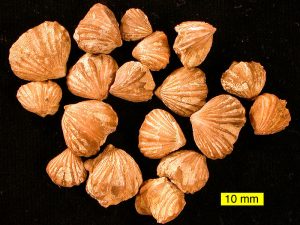You’re going to like brachiopods. They are considerably more complex than the cnidarians, are diverse in both habits and forms, and are the most common fossils in your field collections (for which you should definitely bookmark this Dry Dredger’s webpage on Cincinnatian brachiopods). I suggest starting your web reading with the Wikipedia page on brachiopods, followed by the brachiopod image page on the Paleontology Portal. (This last one is cool because you can select images from different geological periods.) You can also find an enormous number of brachiopod images and links on BrachNet, based in France. The Tree of Life website has a good section on the taxonomy and evolution of brachiopods. Here is a short video of living terebratulid brachiopods on the floor of Monterey Bay, California, and another of brachiopod larvae in Panama. For real excitement, experience a day in the life of a brachiopod.
Brachiopod embryos are playing a role in our hypotheses about the origin of eyes. This is a good New York Times story, but it is tragically headlined: “In a Marine Worm’s Eyes, the Theory of Evolution”. Worm!! I do, though, like the description of one stage of the embryos called “swimming eyeballs”.
Here is a pdf version of the first 2017 Invertebrate Paleontology test you can use to prepare for the Big Event on Thursday, September 20. Remember that each class is different — there will be some items on this sample test that you did not have in your class.

Rhynchonellid brachiopods from the Ordovician of Indiana.
Geology in the News –
Dr. Rick Lehtinen recently named a new frog species after our treasured College of Wooster. This is an honor for Wooster and an accomplishment for Dr. Lehtinen. Guibemantis woosteri is a cute little guy who lives in Madagascar.
Here’s a beautiful map showing streams and rivers of the United States. The watersheds are in separate colors.
Wish we could spend more time with the Kingdom Fungi. Here’s a nice modern summary of their diversity and utility.
